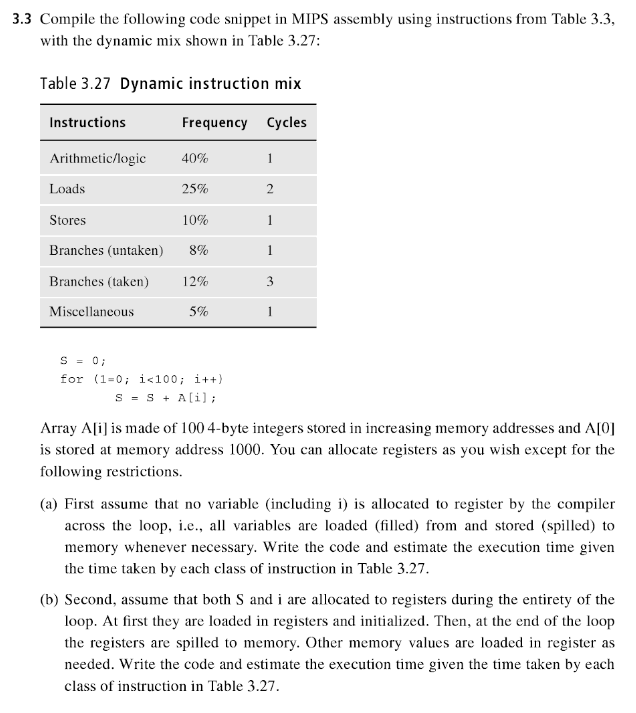
3.3 Compile the following code snippet in MIPS assembly using instructions from Table 3.3, with the dynamic mix shown in Table 3.27: Table 3.27 Dynamic instruction mix Instructions Frequency Cycles Arithmetic/logic Loads Stores Branches (untaken) Branches (taken) Miscellancous 40% 25% 10% 8% 12% 3% S = 0; for (1-0; i 100: i++) S = S + A[i] ; Array Ali] is made of 1004-byte integers stored in increasing memory addresses and A is stored at memory address 1000. You can allocate registers as you wish except for the following restrictions. (a) First assume that no variable (including i) is allocated to register by the compiler across the loop, i.c., all variables are loaded (filled) from and stored (spilled) to memory whenever necessary. Write the code and estimate the execution time given the time taken by each class of instruction in Table 3.27 (b) Second, assume that both S and i are allocated to registers during the entirety of the loop. At first they are loaded in registers and initialized. Then, at the end of the loop the registers are spilled to memory. Other memory values are loaded in register as needed. Write the code and estimate the execution time given the time taken by each class of instruction in Table 3.27 3.3 Compile the following code snippet in MIPS assembly using instructions from Table 3.3, with the dynamic mix shown in Table 3.27: Table 3.27 Dynamic instruction mix Instructions Frequency Cycles Arithmetic/logic Loads Stores Branches (untaken) Branches (taken) Miscellancous 40% 25% 10% 8% 12% 3% S = 0; for (1-0; i 100: i++) S = S + A[i] ; Array Ali] is made of 1004-byte integers stored in increasing memory addresses and A is stored at memory address 1000. You can allocate registers as you wish except for the following restrictions. (a) First assume that no variable (including i) is allocated to register by the compiler across the loop, i.c., all variables are loaded (filled) from and stored (spilled) to memory whenever necessary. Write the code and estimate the execution time given the time taken by each class of instruction in Table 3.27 (b) Second, assume that both S and i are allocated to registers during the entirety of the loop. At first they are loaded in registers and initialized. Then, at the end of the loop the registers are spilled to memory. Other memory values are loaded in register as needed. Write the code and estimate the execution time given the time taken by each class of instruction in Table 3.27







